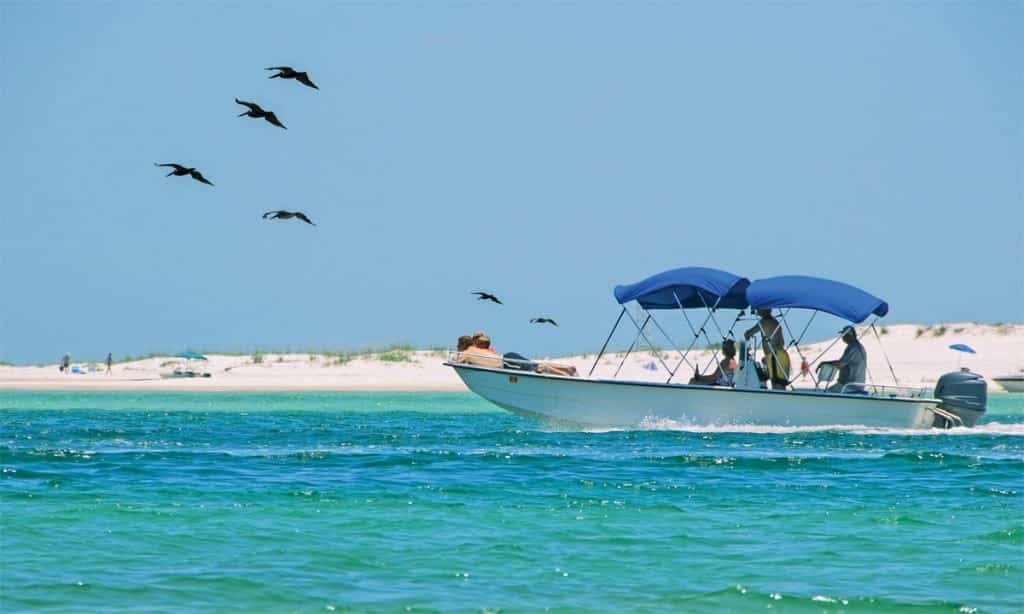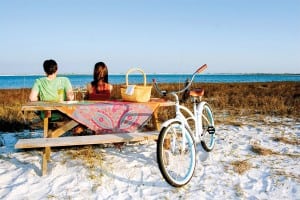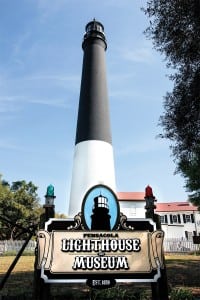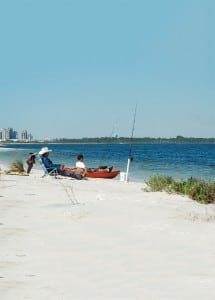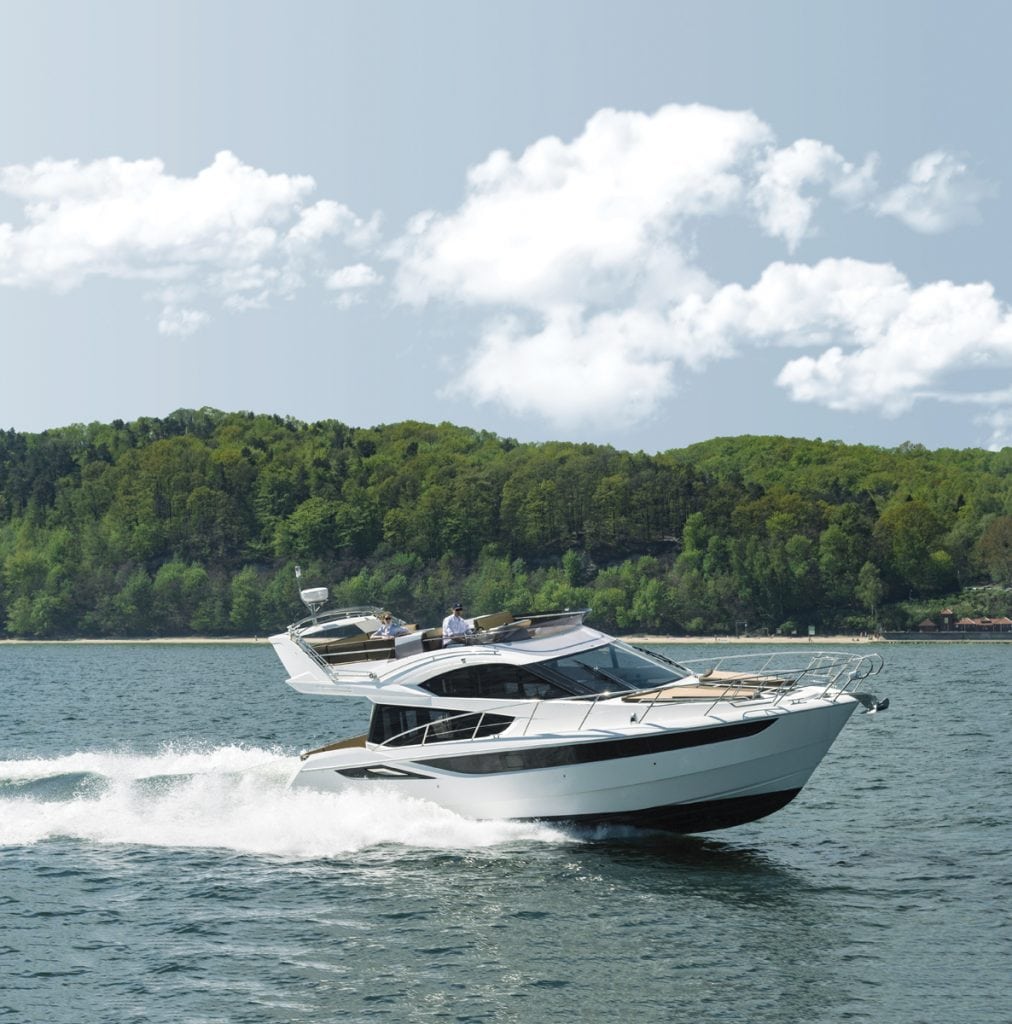Waterfront on the west.
An educational family vacation awaits in Pensacola, Florida, where naval history is all around you.
On the western end of the Florida Panhandle is Pensacola, the state’s second-oldest city and widely known for its great beaches. But Pensacola has also played a major role in the naval history of our country, a role that continues today.
Pensacola Bay is the deepest bay on the Gulf Coast and is protected from the open waters of the Gulf of Mexico by the long barrier island of Santa Rosa to the south. Its importance as a safe harbor and its strategic location led to a Spanish settlement dating back to 1559. (The Native American population being displaced was the custom.) Both the French and English had short-term claims to the land, but mainly the Spanish kept control until 1819, when the land was officially sold to the United States.
The strategic importance of Pensacola Bay was readily apparent, and the U.S. built three forts to guard its entrance: Fort Pickens was established on the west end of Santa Rosa Island, Fort McRee was across the passage on Perdido Key, and Fort Barrancas was built on the mainland over the remains of the original Spanish fort.
With a protected harbor and an abundance of timber, especially live oak, the U.S. government started construction of the Pensacola Navy Yard on the land surrounding Fort Barrancas in 1826; the yard was decommissioned in 1911. By then, the development of the airplane and its possible use by the U.S. Navy led the government to commission Naval Air Station (NAS) Pensacola as the first Naval AirStation in 1914.
Through two World Wars and various military conflicts afterward, NAS Pensacola has provided our country with some of the very best naval aviators. Today, more than 16,000 military and 7,000 civilian personnel are associated with the base.
NAS Pensacola offers a wide variety of things to do and see. Most attractions are free, but keep in mind that this is an active military base. Visitors are welcome, but make sure to carry picture IDs and be prepared for a search of your belongings upon entrance to the base.
NAS is home to the U.S. Navy precision flying team, the famed Blue Angels. Formed in 1946 to boost public interest in naval aviation, the Blue Angels relocated to NAS Pensacola in June 1955. Now in their 71st year, they have performed for nearly 500 million fans. Watch them practice their air show routine for free, and stick around to meet the pilots. Get there early to secure a good vantage point. For practice times, go to blueangels.navy.mil.
When the “Blues” are finished, walk over to the world’s largest naval aviation museum. The National Naval Aviation Museum features 150 restored aircraft from vintage to modern and depicts the history of naval aviation. Entrance to the museum is free, and there are interactive displays and real cockpits the kids can climb into. If you get hungry, the Cubi Bar Café continues the theme of naval aviation and is a fantastic place to get an inexpensive meal.
navalaviationmuseum.org
Only a few minutes away is another landmark, the Pensacola Lighthouse. Completed in 1859, the Pensacola Light has withstood wars, hurricanes and even an earthquake in 1886. The distinctive paint job—the bottom third is white and the top two-thirds is black—makes it clearly visible for miles. A small admission fee allows you to climb the 177 steps to the top of the 150-foot-tall tower, where you’ll have spectacular views of Pensacola Pass, downtown Pensacola and the base itself. You’ll probably see planes flying past, perhaps even the Blue Angels! The lighthouse is open seven days a week from 10AM to 5:30PM. pensacolalighthouse.org
Fort Barrancas is less than a mile away. The original Spanish fort was reconstructed by the Americans from 1839 to 1844. A battery of cannons pointed in the direction of the water to guard entrance to the Bay. The fort is partially underground to prevent damage from enemy bombardment. Travel through the passageways and then go up to the “Parade Ground,” where you’ll have views of the Bay and Santa Rosa Island on the other side.
The Gulf Islands National Seashore (GINS) was established in January 1971 to protect historic landmarks, as well as the birds and wildlife that inhabit the area. If you’d like to boat around the GINS, the National Park Service requires a 20-foot or longer craft to handle the currents and water conditions and also recommends having an up-to-date nautical chart for safe navigation. GINS is the nation’s largest seashore and stretches from Santa Rosa Island west to Cat Island, Mississippi. The Florida side of the GINS consists of six different locations along the water in the Pensacola area (including Fort Barrancas). The park includes the surrounding waters here and, in fact, 80 percent of the protected area is under water. nps.gov/guis/index.htm
Once inside the park, you are in a different world. There are no big hotels and actually, there are not many buildings at all. (There is one general store near the middle of the park.) Instead, there are miles of white-sand beaches with warm, Gulf waters lapping up on them. With an entrance fee and few amenities, the park is not crowded. You’ll find groups of people near the parking lots (only Langdon Beach has a bathhouse), but you don’t have to go far to be alone. Swim, snorkel or dive, lie on the beach, or go surf fishing. Typically, the Gulf is fairly benign in terms of conditions. On the west end of Santa Rosa Island is the Fort Pickens
On the west end of Santa Rosa Island is the Fort Pickens Area, where the fort’s remains still stand. Go on a guided or self-guided tour. Completed in 1834, this pentagon-shaped fort was built with four-foot-thick brick walls to withstand
cannon fi re, and they still survive today. A bookstore and a museum are nearby to further explain the historic significance of the fort.
Anglers can use a fishing pier on the Bay side. With NAS Pensacola just 1.5 miles across the Bay, the Fort Pickens Area is a great place to watch the Blue Angels practice and fly in formation directly overhead. Shutterbugs can get some great shots across the water of the Blues flying past the lighthouse.
Several biking/ hiking/nature trails are also available in the park. The west end of the island broadens out enough to have some freshwater marshes. The Blackbird Marsh Trail near Fort Pickens crosses some of these wetlands, which are home to a wide variety of birds.
In fact, the GINS is part of the Great Florida Birding Trail. Occasionally, sections of the park will be closed to protect nesting shorebirds. The Dune Nature Trail on a boardwalk leads across the dunes to the beach. Sea turtles frequently build nests on the higher parts of the beach and are marked.
The Florida National Scenic Trail starts down the peninsula at the Big Cypress National Preserve and ends at Fort Pickens. It’s worth the trek to see the abundance of fish and dolphin that swim in the nearby offshore waters.
Cruiser Resources & Activities
DINING
Blue Dot Barbecue, Pensacola
(850) 432-0644
McGuire’s Irish Pub, Pensacola
(850) 433-6789
mcguiresirishpub.com
Peg Leg Pete’s, Pensacola Beach
(850) 932-4139
peglegpetes.com
BIKE RENTALS
Bikes Plus, Pensacola
bikesplus.com
Emerald Coast Tours, Pensacola
emeraldcoasttours.net
The Fun Store, Pensacola Beach
funstorefl.com
By Ed Brotak Southern Boating
August 2017

